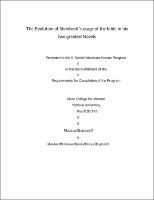Please use this identifier to cite or link to this item:
https://hdl.handle.net/20.500.12202/4490Full metadata record
| DC Field | Value | Language |
|---|---|---|
| dc.contributor.advisor | Shires, Linda | e |
| dc.contributor.author | Linzer, Mairav | |
| dc.date.accessioned | 2019-07-08T22:28:51Z | |
| dc.date.available | 2019-07-08T22:28:51Z | |
| dc.date.issued | 2019-05-07 | |
| dc.identifier.citation | Linzer, Mairav. | en_US |
| dc.identifier.uri | https://hdl.handle.net/20.500.12202/4490 | |
| dc.identifier.uri | https://ezproxy.yu.edu/login?url=https://repository.yu.edu/handle/20.500.12202/4490 | |
| dc.description | The file is restricted for YU community access only. | en_US |
| dc.description.abstract | As evidenced by the titles alone, biblical allusion is central to John Steinbeck’s two most acclaimed works, The Grapes of Wrath (1939) [Afterwards referred to as GOW] and East of Eden (1952) [Afterwards referred to as EOE]. The novels are also replete with biblical symbolism, motifs, and undertones. In fact, key Steinbeck scholars, such as Leonard Slade and Mimi Gladstone, have devoted much of their research to uncovering and unpacking these allusions. Others have argued that in structure, as well, the novels recall or revise central Biblical narratives (see Eckert). Winner of the National Book Award and of the Pulitzer Prize in Fiction, GOW directly recalls the Israelites’ journey and Redemption in the book of Exodus, while EOE takes chapters from the book of Genesis as its model in order to explore central issues of family and sibling rivalry. Biblical narrative plotting is as important to the novels’ success as other kinds of allusions. | en_US |
| dc.description.sponsorship | S. Daniel Abraham Honors Program of Stern College for Women | en_US |
| dc.language.iso | en_US | en_US |
| dc.publisher | Stern College for Women Yeshiva University. | en_US |
| dc.rights | Attribution-NonCommercial-NoDerivs 3.0 United States | * |
| dc.rights.uri | http://creativecommons.org/licenses/by-nc-nd/3.0/us/ | * |
| dc.subject | John Steinbeck | en_US |
| dc.subject | Bible in "Grapes of Wrath" | en_US |
| dc.subject | Bible in "East of Eden" | en_US |
| dc.subject | senior honors thesis | en_US |
| dc.title | The Evolution of Steinbeck’s usage of the bible in his two greatest Novels. | en_US |
| dc.type | Thesis | en_US |
| Appears in Collections: | S. Daniel Abraham Honors Student Theses | |
Files in This Item:
| File | Description | Size | Format | |
|---|---|---|---|---|
| Linzer Final Draft of Honors Thesis.pdf Restricted Access | submitted by HR/SCW | 166.54 kB | Adobe PDF |  View/Open |
This item is licensed under a Creative Commons License

